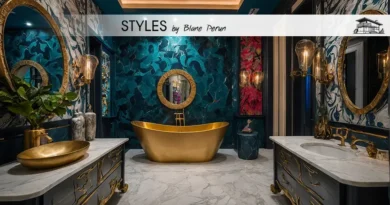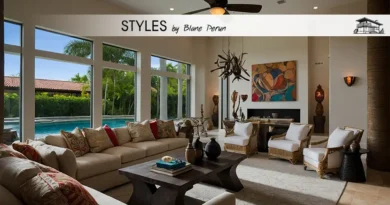Cabin Style
Embracing the Essence of Wilderness: A Guide to Cabin Interior Design
Nestling into the heart of nature, a cabin is more than just a wooden structure; it’s a retreat, a sanctuary where the hustle of city life fades into the serene whispers of the wild. The art of cabin interior design plays a pivotal role in harmonizing these natural elements with human comfort, creating an enclave that not only shelters but also rejuvenates. This guide delves into transforming your cabin into a picturesque haven, infusing elements of the outdoors with the coziness of home. Let’s embark on this journey of crafting interiors that resonate with the tranquility and rustic charm of cabin living.

The Art of Cozy Rusticity
Integrating Natural Materials
In the realm of cabin interior design, the use of natural materials isn’t just a trend; it’s a tribute to the essence of cabin living. Incorporating elements like raw wood (think Pinus sylvestris or Picea abies), stone, and natural fibers into your design can bridge the gap between the indoors and the outdoors. This connection is crucial, as it fosters a sense of continuity that is both grounding and uplifting. Whether it’s through exposed wooden beams, stone fireplaces, or woven rugs, each choice is a step closer to capturing the soul of the wilderness.
Lighting: The Natural Alchemy
The interplay of light within a cabin can transform the mundane into the magical. Emphasizing natural light through large, often floor-to-ceiling windows, skylights, and strategically placed mirrors can amplify the cabin’s connection to its natural surroundings. At dusk, when the sun’s rays retreat, the ambient glow from a classic iron lantern or the soft flicker of candles can mimic the starlit sky, maintaining that delicate balance between the rustic and the mystical.
Harmony with the Elements
Textural Contrasts
The tactile experience in a cabin can significantly enhance the overall ambiance. By juxtaposing rough-hewn wood with soft, plush textiles, or pairing the ruggedness of stone with the delicate touch of linen, you create a dynamic interior landscape. This contrast not only appeals to the senses but also adds depth and character to the space, making each corner a story in itself.
Color Palettes Inspired by Nature
Drawing inspiration from the surrounding landscape, the color schemes within a cabin should reflect the tones and hues of the outdoors. Earthy browns, greens, and the grays of stone and weathered wood can create a seamless visual flow from outside to in. These colors don’t just decorate; they envelop the space in the calming embrace of nature, turning the cabin into a living canvas of the outdoors.
Personal Touches and Comfort
Infusing Personal Memorabilia
A cabin is a personal retreat, and its design should reflect the stories, memories, and experiences of those who dwell within. Displaying personal memorabilia, be it family heirlooms, found objects from nature walks, or photographs of cherished moments, can add layers of meaning and intimacy to the space. These items serve as anchors, connecting the present with the past, and turning the cabin into a tapestry of personal history.
Embracing Modern Comforts
While the appeal of cabin living lies in its simplicity and connection to nature, modern comforts have a place in cabin interior design. Integrating contemporary amenities like efficient heating systems, modern appliances, and comfortable furniture can enhance the living experience without detracting from the rustic charm. The key is in the balance, ensuring that these modern touches blend seamlessly with the natural and historical elements of the cabin.
Cabin interior design is an art form that celebrates the beauty of the natural world and human ingenuity. It’s about creating a space that resonates with the simplicity and serenity of cabin life, while still embracing the comforts and personal touches that make a house a home. As we draw this guide to a close, remember that the essence of cabin design lies in the harmony between the wild and the welcoming, the rustic and the refined.

FAQs on Cabin Interior Design
What are the essential elements in cabin interior design?
Cabin interior design should harmonize with its natural surroundings, making extensive use of natural materials like wood and stone. Essential elements include a warm and earthy color palette, rustic furniture, natural lighting, and cozy textiles that add warmth and comfort. The goal is to create a space that feels both connected to nature and invitingly homely.
How can I make my cabin interior more cozy and inviting?
To enhance the coziness of your cabin, incorporate soft lighting, plush throws, and comfortable seating areas. Use warm, earthy tones and natural materials to create a welcoming atmosphere. Adding a fireplace or wood stove can also increase the warmth and ambiance of the space, making it more inviting.
What role does lighting play in cabin interior design?
Lighting is crucial in cabin interior design for creating ambiance and enhancing the connection to the outdoors. Maximizing natural light through large windows and using strategic interior lighting can bring the beauty of the natural surroundings into the cabin. At night, ambient lighting, such as soft LED fixtures, lanterns, or candles, can maintain a cozy and warm atmosphere, reminiscent of the serene glow of a campfire under the stars.
Can modern amenities be incorporated into cabin interior design without losing its rustic charm?
Absolutely, modern amenities can be seamlessly integrated into cabin interiors without detracting from its rustic appeal. The key is to choose designs and materials that complement the natural, rustic aesthetic. For instance, modern appliances made with traditional materials or finishes, such as a refrigerator with a wood-paneled front, can blend modern functionality with the cabin’s rustic charm. Similarly, incorporating modern comforts like heated floors or smart home technology in a discreet manner can enhance living comfort while preserving the cabin’s traditional feel.
How can I personalize my cabin interior while keeping the rustic theme?
Personalizing your cabin can be achieved through the display of items that hold personal significance, such as family heirlooms, vintage finds, or personal artwork. These elements can add a unique touch to the cabin’s interior without straying from the rustic theme. Customizing furniture pieces made from reclaimed wood or incorporating textiles like handmade quilts can also add a personal touch while enhancing the cabin’s rustic ambiance. Remember, the aim is to create a space that reflects your personality and stories, making the cabin truly feel like a home away from home.





